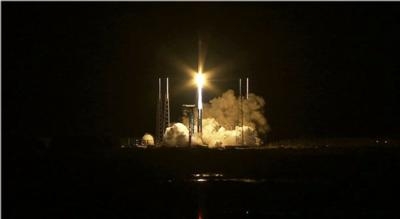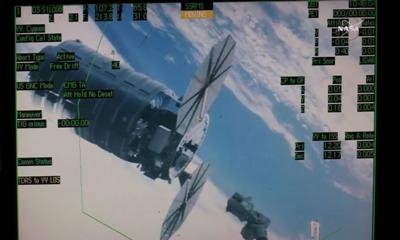Tue, Mar 29, 2016
Cygnus Cargo Vessel Docked With Station Saturday
Scientific investigations of fire in microgravity and grippers inspired by geckos are among the nearly 7,500 pounds of cargo headed to the International Space Station aboard an Orbital ATK Cygnus spacecraft, along with equipment to support some 250 other experiments and studies aboard the world’s only orbital laboratory.

Orbital ATK’s fifth cargo delivery flight under its Commercial Resupply Services contract with NASA launched at 11:05 p.m. EDT Tuesday on a United Launch Alliance Atlas V rocket from Space Launch Complex 41 on Cape Canaveral Air Force Station in Florida. The Cygnus arrived at the orbiting laboratory Saturday, March 26.
The station’s Expeditions 47 and 48 crews will employ these science payloads to support experiments in biology, biotechnology, physical science and Earth science – research that improves life on Earth -- including:
- Saffire-I provides a new way to study a large fire on an exploration craft, which has not been possible in the past because the risks for performing such studies on spacecraft with astronauts aboard are too high.
- Meteor will enable the first space-based observations of meteors entering Earth’s atmosphere from space.
- Strata-I could give us answers about how regolith behaves and moves in microgravity, how easy or difficult it is to anchor a spacecraft in regolith, how it interacts with spacecraft and spacesuit materials, and other important properties.
- The Gecko Gripper study tests a gecko-inspired adhesive gripping device that can stick on command in the harsh environment of space.
- The Additive Manufacturing Facility will add an upgraded 3-D printing capability to the station.
NASA astronaut and Expedition 46 Commander Tim Kopra captured Cygnus at about 6:40 a.m. Saturday, March 26, using the space station's Canadarm2 robotic arm to take hold of the spacecraft.

Saffire-1 will remain on the spacecraft once all the other supplies are unloaded, and the vehicle will be attached to the space station for about two months. Once it departs and the spacecraft is a safe distance from the space station, engineers will remotely conduct the first Saffire experiment before the Cygnus’ destructive reentry into Earth’s atmosphere. Before detaching from the station, Cygnus will also be filled with about 3,000 pounds of trash, which will be burned up over the Pacific Ocean.
This is the second flight of an enhanced Cygnus spacecraft, and the second using the Atlas V launch system. The cargo freighter features a greater payload capacity, supported by new fuel tanks and solar arrays, and an extended pressurized cargo module that increases the spacecraft’s interior volume by 25 percent, enabling more cargo to be delivered with each launch.
(Image provided with NASA news release)
More News
Sikorsky UH-60 Black Hawk Helicopter Collided With An Unregistered DJI Mavic 3T Unmanned Aerial Vehicle On July 7, 2025, about 1557 central daylight time, an unregistered Sikorsky >[...]
“After considering the measures taken, minimum liquidity covenants in the Company's current debt obligations and cash flows to maintain current operational obligations requir>[...]
Ground Clutter A pattern produced on the radar scope by ground returns which may degrade other radar returns in the affected area. The effect of ground clutter is minimized by the >[...]
Aero Linx: Warbirds of America The EAA Warbirds of America, a division of the Experimental Aircraft Association in Oshkosh, Wisconsin, is a family of owners, pilots and enthusiasts>[...]
Also: Louisville UPS Crash Aftermath, Taiwan Boosts Pilot Pool, Spartan Acquires, DON’T MISS the MOSAIC Town Hall! This three-day Affordable Flying Expo brings together indoo>[...]
 NTSB Prelim: Sikorsky UH60 Sikorsky UH-60
NTSB Prelim: Sikorsky UH60 Sikorsky UH-60 Aero-News: Quote of the Day (11.13.25)
Aero-News: Quote of the Day (11.13.25) ANN's Daily Aero-Term (11.13.25): Ground Clutter
ANN's Daily Aero-Term (11.13.25): Ground Clutter ANN's Daily Aero-Linx (11.13.25)
ANN's Daily Aero-Linx (11.13.25) Airborne 11.07.25: Affordable Expo Starts!, Duffy Worries, Isaacman!
Airborne 11.07.25: Affordable Expo Starts!, Duffy Worries, Isaacman!




